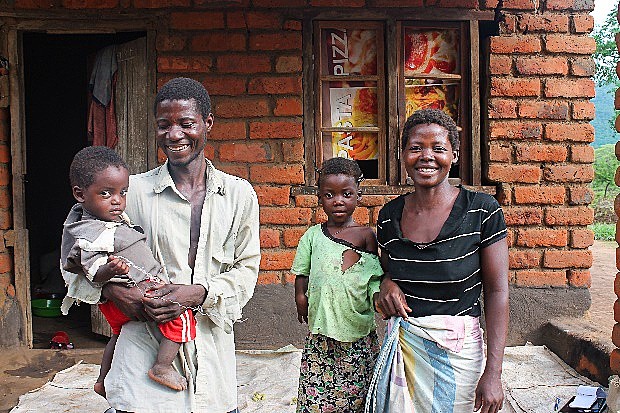Speeches Shim

July 2018 — Heavy clouds loom over the forest that borders 42-year-old Samuel Kosimasi’s farm in Malawi. Here on the border of Liwonde Forest Reserve, Kosimasi hums to himself and leans over a ridge of soil as he expertly inserts leafy vines.
Even without innovative planting equipment, the vines above the dirt’s surface are perfectly spaced. He knows nutritious orange-fleshed sweet potato roots will soon start forming under the soil.
Kosimasi is not the only farmer tending to his field this morning. In the surrounding fields, other farmers are applying fertilizer to their maize fields. They planted after the first rains in mid-November. As they apply the expensive fertilizer to each maize plant, they say a silent prayer that their crop will yield enough food for the year.
This year’s rainy season created hope when it started early, but its inadequate rains and sporadic dry spells have only compounded the effect of Malawian farmers’ new worst enemy — the maize-loving fall armyworm.
When the others celebrated the early rains and rushed to plant their maize, Kosimasi patiently waited. As the rainy days passed, his neighbors warned him that if he did not plant soon, his family would go hungry.
But Kosimasi had a plan. He nodded knowingly when he heard their warnings, but still he waited. His patience paid dividends in the previous farming seasons, and he was confident it would do so again this rainy season.
Farmers like Kosimasi didn’t dedicate much of their land to orange-fleshed sweet potatoes until USAID began working with them to showcase the benefits of the root vegetable. After the sweet potato’s attributes of high vitamin A content and drought tolerance were explained, a total of 7,500 farmers over three farming seasons, from 2015 to 2018, signed up to participate in the project.
Kosimasi and his wife, Eliza, planted the 300 cuttings they received and hand-watered the vines until the rains began. After planting, they monitored the vines carefully. Soon, their sweet potato vines were flourishing, and they made an unconventional decision.
Remembering USAID’s promises of the crop’s high nutritional value and drought tolerance, they decided to plant only orange-fleshed sweet potatoes instead of maize.
During the 2016-2017 farming season, many of their neighbors’ maize fields were stunted by drought and attacked by fall armyworm, but the Kosimasi’s field of sweet potatoes comfortably grew beneath the soil, protected from pests and drought.
When the couple began to harvest the sweet potatoes, they were amazed by how well they had grown. The Chipika variety grew so big that they nicknamed the variety “Chipona,” or “Giant.” Eliza learned to love the Chipona variety. “One sweet potato feeds my whole family!” she exclaimed.
The couple traded some of their sweet potatoes for maize and, by June, they had harvested and exchanged their sweet potatoes for seven bags of maize. Kosimasi estimates that, with the drought and fall armyworm conditions, “I would have only harvested three to five bags of maize from the field had I planted maize last year.” Instead, he had seven bags for his family and had saved money by not buying fertilizer, as sweet potatoes grow well without fertilizer.
Realizing the giant potential of this new, nutritious crop, the couple immediately planted more vines back into their garden and irrigated the plants when the rains stopped. When businessmen from nearby markets heard there were orange-fleshed sweet potatoes in the area, they traveled to the garden to buy them.
By November, the couple sold all their sweet potatoes. With their profits, they were able to pay secondary school fees for their niece and buy a pregnant goat.
Kosimasi, proud of his new spending power, reported, “We will continue to grow OFSP [orange-fleshed sweet potatoes] because we see a lot of future in OFSP as healthy food and business.”
And today he is maintaining this new family tradition as he confidently walks the lengths of his ridges and buries another vine cutting into the soil. Today is planting day.
Over one-third of Malawian children suffer from chronic malnutrition. Consumption of orange-fleshed sweet potato is a proven approach to improve nutrition and reduce vitamin A deficiency. USAID, through the Feed the Future Malawi Improved Seed Systems and Technologies project, has provided 56,000 farming households in Malawi with planting material and training.
Through its support to the International Potato Center, USAID also contributes to the multi-partner Sweet Potato for Profit and Health initiative that seeks to reduce child malnutrition and improve smallholder incomes in 10 million African families by 2020 through the effective production and expanded use of sweet potato.
LINKS
Follow @USAIDMalawi, on Facebook, on Flickr

Comment
Make a general inquiry or suggest an improvement.